
Assignment 9 Write-up

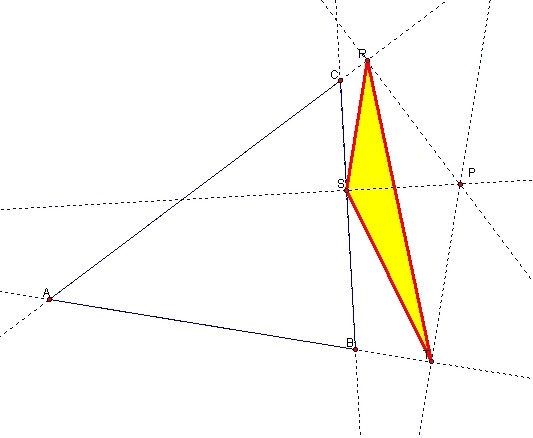 Here is a GSP script for the
pedal triangle.
Here is a GSP script for the
pedal triangle.
Now, let's do some explorations, shall we?
What if pedal point P is the centroid of triangle ABC?
 When
I first started playing with this sketch, I thought that the pedal triangle
would always stay fully inside triangle ABC. However, I began to notice
that if triangle ABC possessed a very small angle and the opposite side of the
angle possessed a small measurement, then part of the pedal triangle could be
seen outside of the ABC triangle.
When
I first started playing with this sketch, I thought that the pedal triangle
would always stay fully inside triangle ABC. However, I began to notice
that if triangle ABC possessed a very small angle and the opposite side of the
angle possessed a small measurement, then part of the pedal triangle could be
seen outside of the ABC triangle.
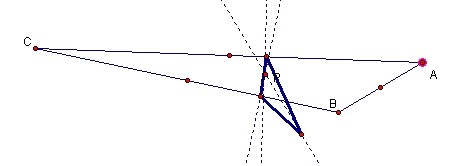 Therefore,
the only thing I can conclude about this sketch is that the pedal point P will
always lie inside the triangle since the centroid always lies inside the
triangle. Also, whenever part of the pedal triangle "leaves" the original
triangle, it always leaves by way of one of the three vertices.
Therefore,
the only thing I can conclude about this sketch is that the pedal point P will
always lie inside the triangle since the centroid always lies inside the
triangle. Also, whenever part of the pedal triangle "leaves" the original
triangle, it always leaves by way of one of the three vertices.
What if pedal point P is the incenter of triangle ABC?
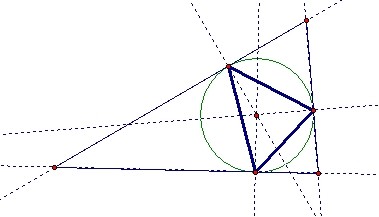 One
can see that each of the vertices of the pedal triangle is tangent to triangle
ABC. Now since the pedal triangle is constructed by connecting the
intersections of the original triangle and its perpendiculars, and since the
incenter is equidistant from each side of the triangle, we know that the radius
of the inscribed circle equals the distance from P to each vertex of the pedal
triangle.
One
can see that each of the vertices of the pedal triangle is tangent to triangle
ABC. Now since the pedal triangle is constructed by connecting the
intersections of the original triangle and its perpendiculars, and since the
incenter is equidistant from each side of the triangle, we know that the radius
of the inscribed circle equals the distance from P to each vertex of the pedal
triangle.
What if pedal point P is the
orthocenter of triangle ABC?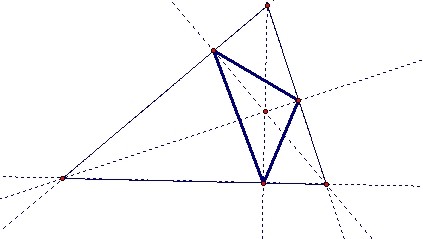 Nothing
much to see here; it looks like R, S, and T once again are tangent to triangle
ABC. Also, the pedal triangle is actually by definition an orthic
triangle. However, look at what happens when P/orthocenter lies outside
the triangle. . .
Nothing
much to see here; it looks like R, S, and T once again are tangent to triangle
ABC. Also, the pedal triangle is actually by definition an orthic
triangle. However, look at what happens when P/orthocenter lies outside
the triangle. . .
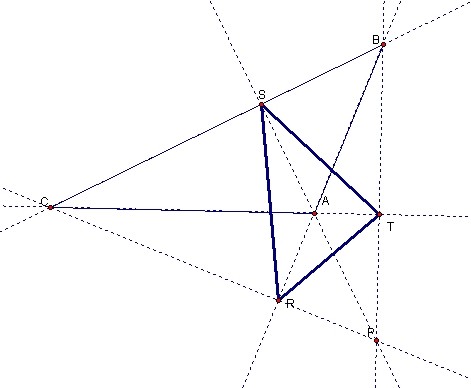 Two
of the vertices of the pedal triangle lie on the altitudes of ABC! (That's
about all I can come up with.)
Two
of the vertices of the pedal triangle lie on the altitudes of ABC! (That's
about all I can come up with.)
Last but not least, I want to look at what happens if point P lies on one of the sides of triangle ABC.
 As
you can see, point P collapses onto one of the three vertices R, S, or T.
This is because P is the intersection of all three perpendiculars, and when P is
put onto one of the sides, it must still be "on the line" perpendicular to that
particular side and that point just happens to be R, S, or T. Looking at
this picture makes me wonder about something. If P lies on a side, will
angle P always be obtuse? Well don't look at me for the answer!
Click here to investigate for yourself.
As
you can see, point P collapses onto one of the three vertices R, S, or T.
This is because P is the intersection of all three perpendiculars, and when P is
put onto one of the sides, it must still be "on the line" perpendicular to that
particular side and that point just happens to be R, S, or T. Looking at
this picture makes me wonder about something. If P lies on a side, will
angle P always be obtuse? Well don't look at me for the answer!
Click here to investigate for yourself.